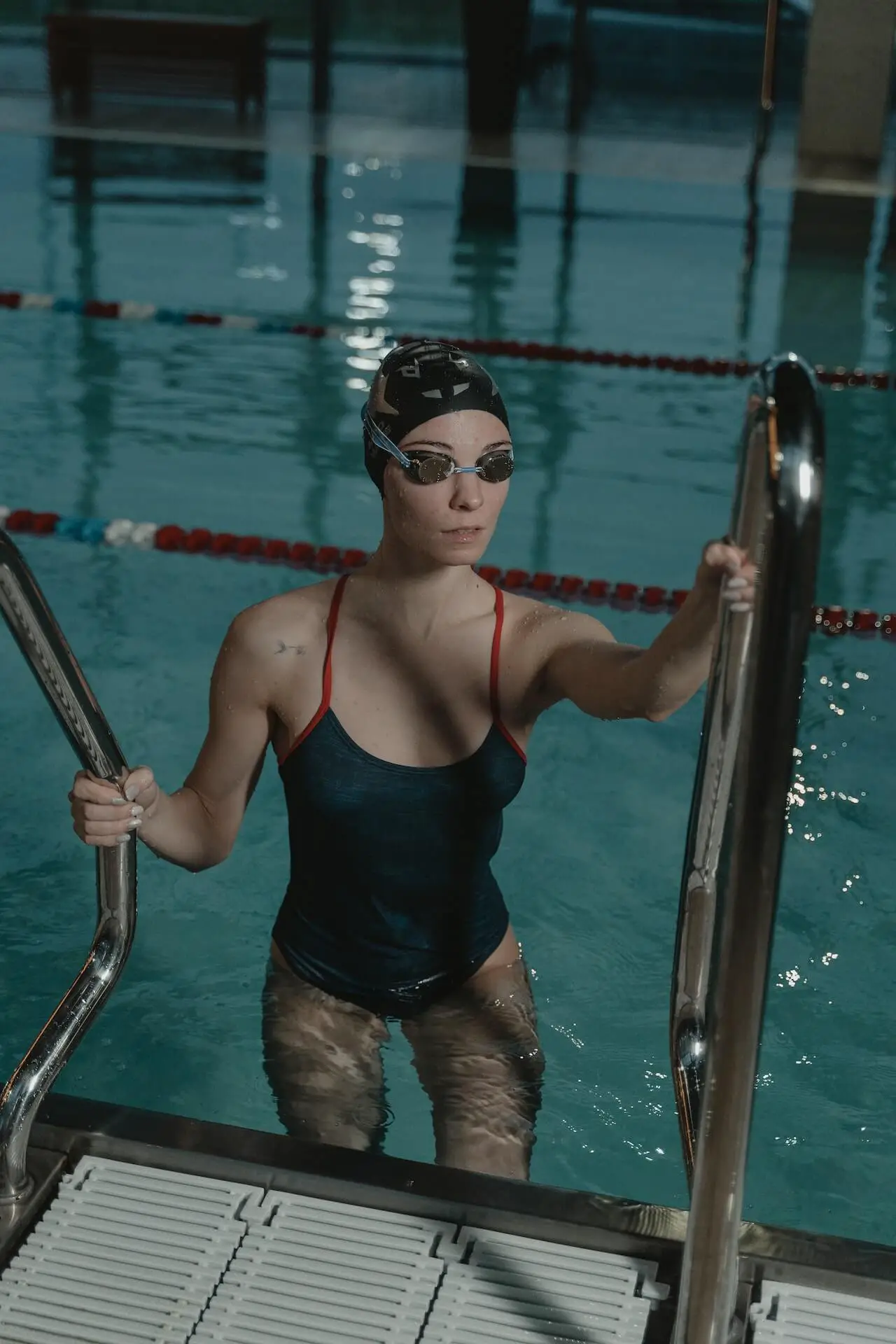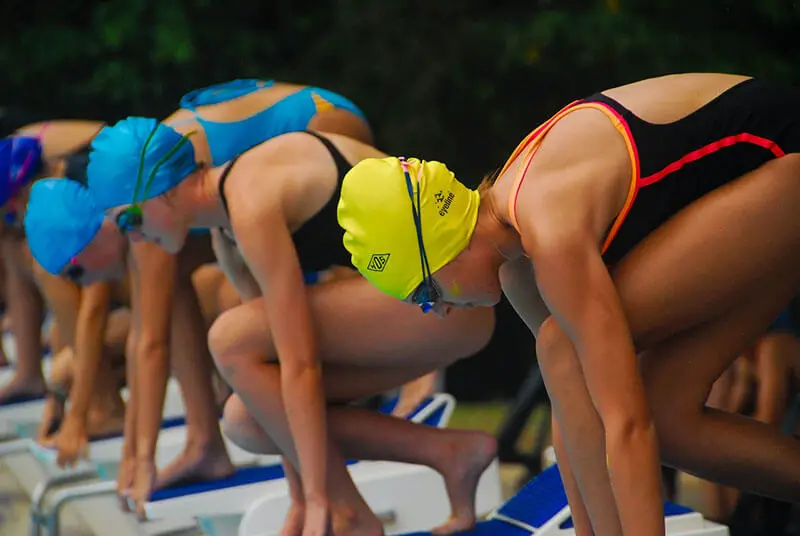Excelling at swimming requires intensive training, dedication, and determination. The physical demands of swimming can result in a unique physique, often leading to the appearance of smaller breasts in female athletes. You might be wondering why this happens and what factors contribute to this phenomenon.

Breasts are made up of both glandular tissue and fat, with the proportions largely depending on genetic factors. As female swimmers train, they tend to develop low body fat levels, which decreases their breast size. Additionally, the repetitive, intensive upper body workouts can cause the development of strong pectoral muscles that may further contribute to a streamlined appearance.
In this article, we will discuss how these physical changes are a natural result of the sport, and ultimately enhance a female swimmer’s performance in the pool. Rest assured that at the end of the day, these athletes are healthy, strong, and dedicated to their passion for swimming.
Understanding the Swimmer’s Physique
Swimmers’ Body Composition
As a female swimmer, your body composition plays a significant role in your performance in the pool. In sports like swimming, a lean body with a lower body fat percentage can offer you a competitive edge.
Body fat distribution varies among athletes, with swimmers typically having a lower body fat percentage than athletes in sports like gymnastics or basketball.
One reason behind this is that swimmers require a higher level of endurance and need to minimize drag in the water. A streamlined physique with a balanced distribution of muscles and fat can help you glide through the water more efficiently.
Thankfully, the sport itself burns a lot of calories, so swimmers rarely need to go out of their way to lose body fat; it will happen naturally as a matter of course.
While your body type and genetics also influence your body composition, with dedicated training and a healthy diet, you can optimize your body for swimming.
The Impact of Intense Training on Body Fat
Intense training sessions and long hours spent in the pool can cause female swimmers to have smaller breasts. This is due to the reduction in body fat, which directly affects your breast size.
Breasts consist mainly of glandular tissue and fatty tissue, with fat making up a significant portion of their composition.
When you engage in rigorous, high-intensity endurance training, your body’s energy demands increase, which can result in burning more fat for fuel. This extensive exercise, combined with a carefully planned diet to meet your energy needs and minimize fat gain, can lead to a decrease in overall body fat levels, including in the breast area.
Why Female Swimmers Have Less Prominent Breasts

Perception vs Reality
When you look at female swimmers, especially those competing at an elite level, you might notice that their breasts appear smaller than those of non-swimmers.
This is partly due to the fitting nature of their swimsuits, which compress and flatten the breasts, creating a streamlined appearance. Additionally, swimmers often have strong shoulder muscles that can make their breasts appear smaller in proportion.
Nevertheless, any perceived lack of breast size among female swimmers is not entirely accurate. Just like in other sports, there are athletes with varying body shapes and sizes in swimming. Therefore, try not to fall for the idea that all female swimmers have smaller breasts, as this may be a trick of your eyes rather than reality.
Breast Size & Swimming Efficiency
The athletic demands of swimming can contribute to differences in breast size among female swimmers. Regular training sessions strengthen your chest and arm muscles, which, in turn, can cause a natural reduction of breast tissue and fat. Swimmers usually have leaner body compositions, which could lead to smaller breasts than those of an average sedentary woman.
Furthermore, breast size can affect swimming efficiency, as larger breasts may create additional water resistance and slightly decrease performance. Consequently, having smaller breasts might be advantageous for competitive swimmers seeking to maximize their speed and agility in the water.
In fact, this is not a benefit exclusively found in swimming. In general, larger breasts can cause discomfort and pain during physical activity and can also lead to poor posture. Breasts are a hindrance to female athletes because they can get in the way or slow them down at their respective sport. There are no benefits to having larger breasts in sports.
Therefore, women who naturally have smaller breasts will tend to excel in athletics over women with larger breasts, which is why at the highest levels of competition, most female athletes have small breasts.
However, breast size alone does not dictate a swimmer’s success or ability. Factors such as technique, endurance, and mental strength play a much more significant role in determining performance levels.
Swimming and Breast Size
Does Swimming Reduce Breast Size?
Swimming is an excellent form of exercise that engages different muscle groups, including the pectoral muscles found in your chest. While swimming regularly can help tone these muscles, it doesn’t directly reduce breast size.
However, weight loss from regular exercise could indirectly lead to a decrease in breast size. You see, breasts are made up of glandular tissue and fat, and a change in your overall body fat might change your breast size as well.
Genetics vs Exercise: What Influences Breast Size More?
Both genetics and exercise play a role in determining your breast size, but genetics likely has the most significant influence.
Everyone’s body is predisposed to store fat in certain areas, meaning some people may store fat more readily in their breasts. When you lose fat, you can’t control where your body decides to shed it first.
That means that even if you lose breast size during weight loss from regular exercise, such as swimming, it’s not directly a result of the exercise itself but rather due to the overall loss of body fat.
While exercise can help strengthen the chest muscles and ligaments, this won’t have a direct impact on breast size. However, improved muscle tone can provide better support to your breasts, which might make them appear firmer.
It’s also worth noting that endurance training, such as swimming, can decrease overall body fat, so there might be a detectable change at a certain point, but this may vary from person to person.
To sum it up, swimming and other forms of exercise can contribute to changes in breast size, but primarily as a result of overall weight loss and fat distribution. Genetics is a more significant factor when it comes to determining breast size, and exercise cannot radically alter what you are genetically predisposed to have. So, embrace your unique body shape, and focus on the health benefits and enjoyment you get from swimming rather than trying to alter your breast size through exercise.
Sources:
